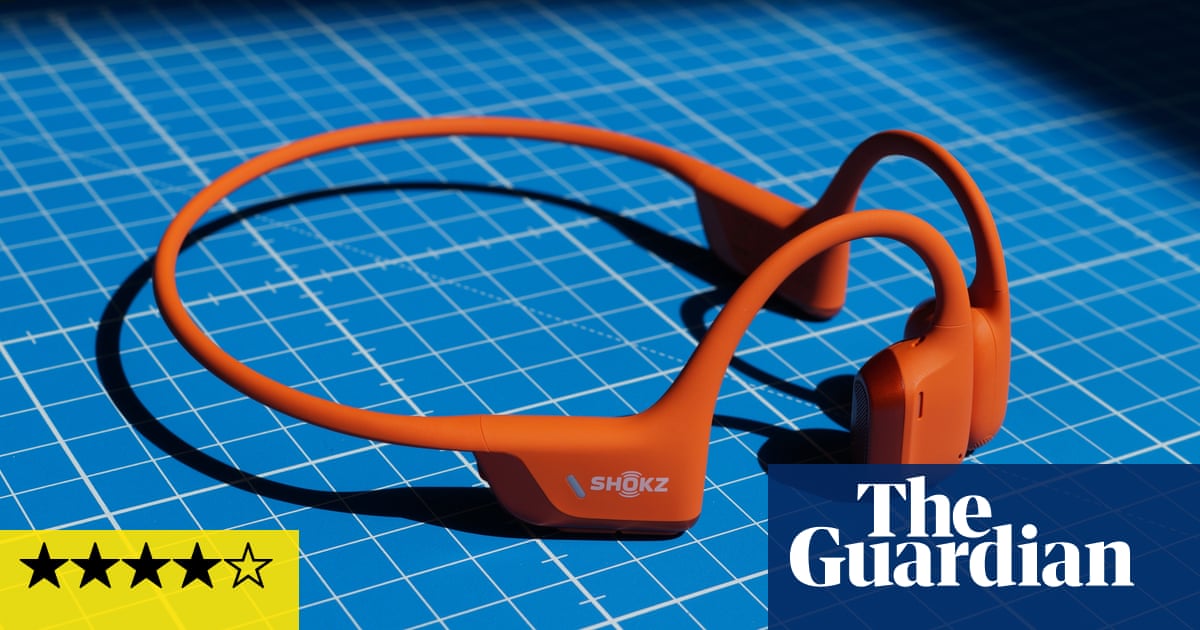So-called bone conduction headphones are a runner’s best friend, allowing you to be fully aware of the outside world while you listen to your motivational tunes. But the technology simply can’t generate decent bass – a problem that the open-ear headphone firm Shokz thinks it has solved with its latest OpenRun Pro 2.
The follow-up to the popular OpenRun Pro and OpenSwim lines, the OpenRun Pro 2 cost £169 (€199/$175/A$299) and resemble most competitors, with bone conduction pods held in place in front of the ear by two loops and a band that runs behind your head.
What makes these headphones unique is that the pods also contain open-air speakers that direct music towards your ears on the outside. They work in tandem with the bone conduction speakers, which vibrate your cheekbones to send sound directly to your inner ear. The open-air speakers handle the low tones, and the rest is fed to the listener via bone conduction.
They can’t produce skull-shaking bass like a big set of over-ear headphones. But the OpenRun Pro 2 sound fuller and more rounded than their predecessors, and don’t create the same intense vibrations across your cheek when playing at high volume. Instruments, drums and vocals have more depth, which is particularly good for podcasts and dance tracks. An equaliser is available in the Shokz smartphone app to tweak how the headphones sound, along with other updates and adjustments.
But the open-air speakers also mask more background noise, reducing your awareness of cars, bikes and other runners to a greater degree than traditional bone conduction headphones. They are still far superior to earbuds and other headphones, but the difference was noticeable at medium volume levels while running.
Close bystanders can hear your music to a slightly greater degree than regular bone conduction sets but only when the volume is cranked up by 50%. It is less obtrusive than is the case with cheap earbuds and certainly isn’t loud enough to be a problem when out running.
Specifications
-
Water resistance: IP55 (spray resistant)
-
Connectivity: Bluetooth 5.3 (SBC)
-
Battery life: 12h
-
Dimensions: 30.9 x 21.7 x 24.3mm
-
Weight: 30.3g
-
Drivers: Air and bone conduction
-
Charging: USB-C
Bluetooth upgrade and comfortable fit
Another big upgrade from previous Shokz is Bluetooth 5.3 support with multipoint – meaning two devices can be connected to them simultaneously. This is particularly handy if you connect them to a running watch and phone at the same time, so you can listen to music and lap guidance from the watch but also take calls without stopping.
The headphones fit really well, with a good balance between the front and rear of your ear. The band around the back of your head has a good amount of flexibility and keeps enough pressure on the side of your head, without squeezing too hard. A mini version is also available for those who need a tighter fit.
Volume buttons are on the body of the headphones behind your right ear, while a multifunction button for controlling playback is on the outside of the pod in front of your left ear. A mic for calls is in the right pod and works well enough, though callers said I sounded a bit distant and quiet.
The battery lasts 12 hours between charges and fully charges via a USB-C port in about an hour. The headphones are spray-resistant to survive even the sweatiest run but they are not safe from immersion in water.
Sustainability
Shokz says the batteries in the earbuds and case will maintain at least 80% of their original capacity for 800 full-charge cycles. Shokz does not offer trade-in, recycling or repair services and the battery cannot be replaced. The headphones do not contain any recycled materials and the company does not publish environmental impact reports.
Price
The OpenRun Pro 2 cost £169 (€199/$175/A$299).
For comparison, the Shokz OpenRun cost £130, the Suunto Wing cost £145, the Creative Outlier Free Pro+ cost £80, and the Bose Ultra Open earbuds cost £250.
Verdict
The OpenRun Pro 2 solve the problem of lack of bass with bone conduction headphones by augmenting them with open-air speakers to handle the low tones.
They won’t produce skull-shaking bass but they sound as full as a set of standard earbuds, marking a step up in quality over what has come before. But the trade-off is slightly worse situational awareness when turned up to a medium volume level. That’s not a deal-breaker for me – but if you want your running music nice and loud, it might defeat the object of buying bone conduction headphones.
The added Bluetooth multipoint to connect to two devices at the same time is handy, as is the 12-hour battery life and charging via a standard USB-C cable, not some proprietary port.
The Shokz are not cheap and are not suitable for use as a general set of headphones. But their biggest problem is that they cannot be repaired and the battery cannot be replaced, ultimately making them disposable and losing them a star.
Pros: much more rounded sound than just bone conduction, open-air awareness, spray resistance, solid battery life, standard USB-C charging, Bluetooth multipoint, great for running.
Cons: slightly less awareness than just bone conduction on its own, expensive, no high-quality bluetooth audio format support, cannot be repaired, battery cannot be replaced.

